

Nestled in the southwest of Scotland, Ayrshire is a region rich in history and natural beauty. Among its rolling hills and rugged coastline lie some of Scotland’s most fascinating and picturesque castles. These structures, built centuries ago, stand as testament to the tumultuous history and cultural heritage of the area. Ayrshire’s castles are not just remnants of the past; they are vital pieces of the puzzle in understanding Scotland’s complex history and the many layers of stories and battles that shaped it. Today, they attract history buffs, architecture enthusiasts, and tourists from all over the world, eager to explore their ancient halls and learn the secrets they hold.
History of Castles in Ayrshire
The story of Ayrshire’s castles begins in the early medieval period, a time when Scotland was a patchwork of competing kingdoms and clans. The strategic importance of Ayrshire, with its access to the sea and fertile lands, made it a coveted area, leading to the construction of numerous fortifications. Early castles in Ayrshire were primarily motte-and-bailey structures—earthen mounds with wooden palisades, designed for quick construction and defense against raids. As the threat of invasion and internal conflict grew, these were gradually replaced by more durable stone castles.
The construction of stone castles in Ayrshire accelerated under the reign of the Scottish kings, who sought to assert their control over the region. These fortifications served not only as military bastions but also as symbols of power and authority. The 12th and 13th centuries saw significant castle-building activity across Scotland, including Ayrshire, as part of a broader trend towards the feudalization of the Scottish kingdom.
Key historical events, such as the Wars of Scottish Independence in the 14th century, left indelible marks on the castles of Ayrshire. Many castles were besieged, captured, and recaptured as control of the region shifted between Scottish and English forces. These conflicts led to the reinforcement and remodeling of existing castles, as well as the construction of new fortresses.
Famous Castles in Ayrshire
Ayrshire is home to several castles, each with its own unique history and architectural features. Let’s explore some of the most notable ones.
Culzean Castle
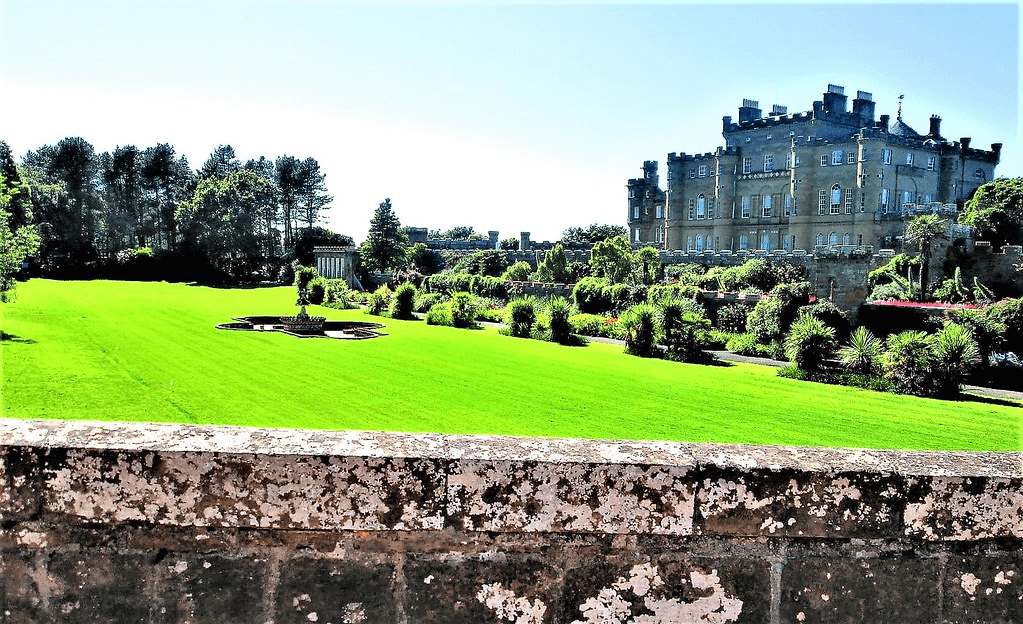










Brief History: Culzean Castle, pronounced “Cullane,” is a masterpiece of 18th-century architecture, nestled atop a dramatic cliff on the Ayrshire coast. Designed by Robert Adam, one of Scotland’s most celebrated architects, it was completed in 1792 for the 10th Earl of Cassillis. The Kennedy family, one of Scotland’s most prominent families, has called the castle and its surrounding 600-acre estate home for centuries. Culzean Castle is famed not only for its architectural beauty but also for its role in Scottish history, including its use as a presidential retreat for Dwight D. Eisenhower after World War II.
Architectural Highlights: The castle is a stunning example of Adam’s neoclassical style, featuring exquisite interiors, elegant furnishings, and ornate decorations. Its most notable features include the Oval Staircase, the Round Drawing Room with its panoramic views of the sea, and the Armoury, which houses one of the largest collections of flintlock pistols and swords in Scotland.
Visitor Information: Culzean Castle is a well-preserved estate open to the public. Managed by the National Trust for Scotland, it offers a variety of activities including castle tours that delve into its history and architecture, extensive gardens and woodlands to explore, and a country park that hosts events throughout the year. The estate also offers accommodation, with the Eisenhower Hotel located within the castle itself, providing a unique opportunity to stay in historic surroundings.
Kelburn Castle






Brief History: Kelburn Castle, dating back to the 13th century, is one of Scotland’s oldest castles and has been the ancestral home of the Earls of Glasgow. This castle blends its medieval roots with a touch of modern flair, famously known for the graffiti art that adorns its exterior walls, created by Brazilian artists in 2007 as part of a temporary art project that has since become a permanent feature.
Architectural Highlights: While the castle retains its historic structure, the contemporary graffiti art covering its facade presents a striking contrast that has made Kelburn Castle a unique cultural landmark. Beyond its vibrant exterior, the castle grounds feature beautifully landscaped gardens, waterfalls, and wooded areas that reflect centuries of careful cultivation and design.
Visitor Information: Kelburn Castle and its estate offer a wide range of family-friendly activities, including the Secret Forest, a play area that takes visitors on a magical journey through themed gardens and mystical woodland. The estate also hosts events, festivals, and workshops throughout the year. Although the castle itself is not always open to the public for interior tours due to it being a family home, the extensive grounds and gardens provide plenty of attractions for visitors.
Photo Attribution: wfmillar / Kelburn Castle / CC BY-SA 2.0
Dunure Castle








Brief History: Situated on the rugged coast south of Ayr, Dunure Castle’s ruins tell a story of power, conflict, and alliance that dates back to the 13th century. Originally serving as the ancestral seat of the Kennedy family, a name synonymous with Ayrshire’s history, the castle played a crucial role in the region’s medieval power dynamics. Its history is marked by its involvement in the Wars of Scottish Independence and its role in local feuds and national politics.
Architectural Highlights: Though now in ruins, Dunure Castle’s remnants still impress, offering a glimpse into medieval defensive architecture. The castle’s location on a cliff overlooking the sea exemplifies strategic siting, with its keep, defensive walls, and the unique ‘beehive’ dovecot highlighting its former strength. Visitors can still discern the layout of rooms, halls, and the once-imposing entrance.
Visitor Information: Dunure Castle is freely accessible to the public year-round. There are no formal visitor facilities, but the site’s dramatic coastal setting makes it a popular spot for picnics, photography, and exploring the rugged landscape. Nearby, the village of Dunure offers parking and basic amenities, making the castle a perfect starting point for exploring the wider area.
Greenan Castle
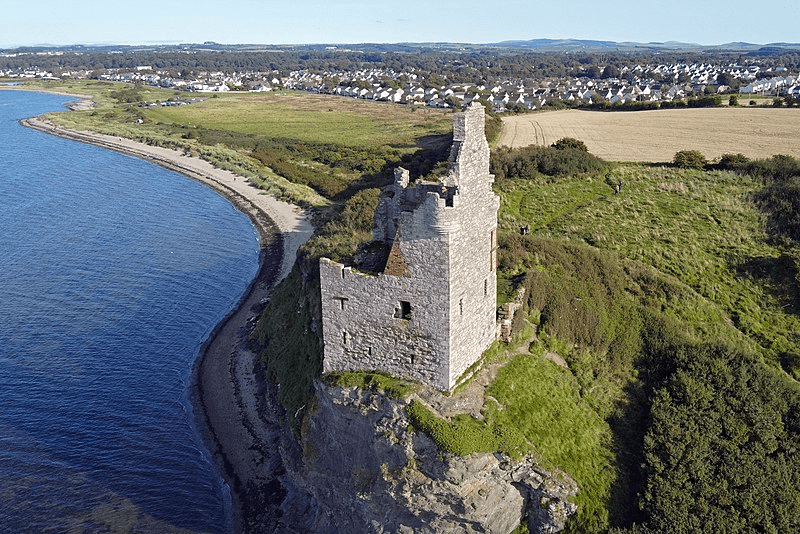





Brief History: Greenan Castle, perched on a cliff edge overlooking the Firth of Clyde, dates back to the 16th century, though its site has been fortified since the 12th century. This tower house was once a formidable stronghold of the Boyd family, an important name in Scottish history. Its strategic location served both defensive and signal purposes, but like many castles of its era, it fell into disuse and ruin over the centuries.
Architectural Highlights: The ruins of Greenan Castle, though limited, are evocative, with its tower standing defiant against the sea. The remnants suggest a once robust structure, with features typical of Scottish tower houses, including thick walls and narrow windows. The site’s dramatic setting adds to its allure, offering stunning views of the coast and the opportunity to contemplate the passage of time.
Visitor Information: Access to Greenan Castle is via a short walk along the coast from the nearby road. The site is open to the public, though care should be taken when exploring due to its cliff-top location. There are no visitor facilities at the castle itself, but its beauty and historical aura make it a worthwhile stop for those interested in Scotland’s medieval past.
Photo Author Dfeehely
Rowallan Castle
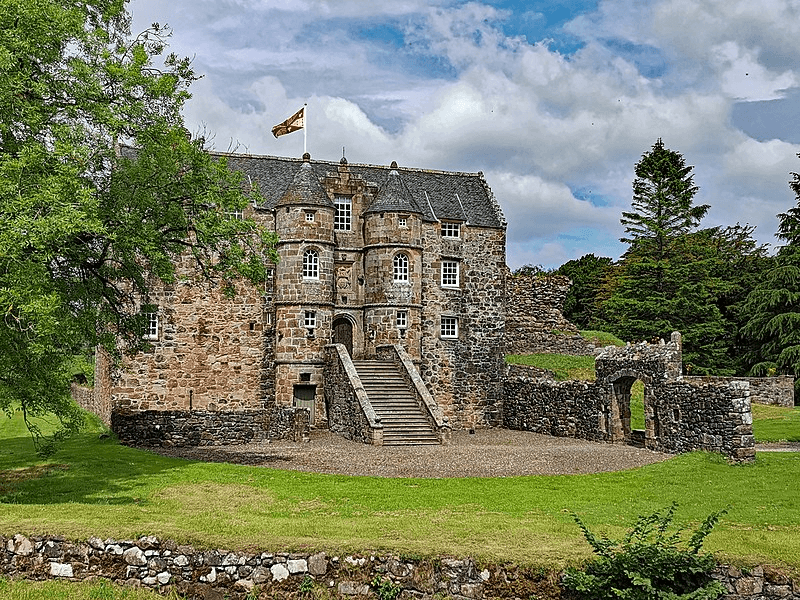







Brief History: Rowallan Castle, nestled in the Ayrshire countryside, boasts a history that spans several centuries, with its oldest parts dating back to the 13th century. The castle is renowned not just for its architecture but also for its connection to Scottish culture, having been the birthplace of Elizabeth Mure, wife of Robert II, and thus a significant site in the lineage of the Stewart kings. Over the years, Rowallan has seen various phases of construction and renovation, reflecting the changing tastes and fortunes of its occupants.
Architectural Highlights: The castle comprises two distinct parts: the Old Castle, with its medieval origins, and the New Castle, a Renaissance-era mansion added in the 17th century. The Old Castle offers an insight into medieval living conditions, with its vaulted hall and defensive features, while the New Castle showcases more comfortable, refined living spaces and architectural detail.
Visitor Information: Rowallan Castle is now part of a larger estate that includes golf courses and event venues. The New Castle serves as a luxury venue for weddings, corporate events, and private stays. Although access to the interior of the Old Castle is restricted, the estate offers guided tours by appointment, allowing visitors to experience the beauty and historical depth of the site. The surrounding grounds, with their carefully maintained gardens and natural beauty, are also a draw for visitors looking to enjoy a peaceful day out in the countryside.
Photo Author PaulT (Gunther Tschuch)
Dean Castle
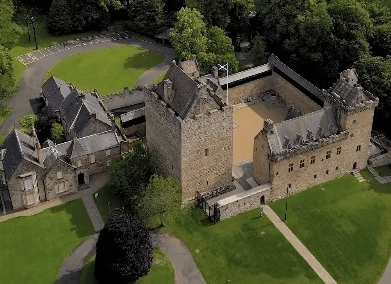





Brief History: Dean Castle, located in the heart of Kilmarnock, boasts a rich history dating back to the 14th century. Originally the stronghold of the Boyd family, the castle played a significant role in Scottish history, including connections to the royal family and involvement in national conflicts. Over the centuries, Dean Castle has seen various phases of expansion and renovation, reflecting the changing architectural styles and fortunes of its owners.
Architectural Highlights: The castle complex comprises two main parts: the Keep and the Palace. The Keep, built in the 14th century, is a fine example of medieval architecture, featuring a robust defensive structure. The Palace, added in the 15th century, showcases Renaissance influences with its more refined and comfortable living quarters. Inside, the castle houses an impressive collection of historical artifacts, including arms and armor, musical instruments, and tapestries.
Visitor Information: Dean Castle and Country Park are now managed by the local council and are open to the public. Visitors can explore the beautifully restored interiors of the Palace, participate in guided tours to learn more about the castle’s history, and enjoy the extensive country park that surrounds the castle. The park offers walking trails, a playground, and a variety of wildlife, making it a perfect destination for a family day out.
Photo Author Goodreg3
Dalquharran Castle








Brief History: Dalquharran Castle, situated in the picturesque countryside of South Ayrshire, is a striking example of 18th-century architecture. Designed by the renowned architect Robert Adam, the castle was built for the Kennedy family, marking a significant departure from traditional medieval fortress designs towards more elegant, classical styles. Despite its architectural beauty, Dalquharran Castle fell into disuse in the 20th century and now stands as an imposing ruin.
Architectural Highlights: The castle’s design reflects the neoclassical style popular in the 18th century, with grand facades, detailed stonework, and symmetrical layouts. Although the interior is no longer accessible due to its ruined state, the exterior walls and some architectural features remain, offering a glimpse into its past splendor.
Visitor Information: As a ruin, Dalquharran Castle is not officially open to the public, and access may be restricted. Visitors can view the castle from nearby public roads and footpaths, but they should exercise caution and respect private property signs. The castle’s dramatic silhouette against the landscape continues to attract photographers and history enthusiasts, offering a poignant reminder of the region’s architectural heritage.
Photo Attribution: paul c / Dalquharran Castle / CC BY-SA 2.0
Dundonald Castle
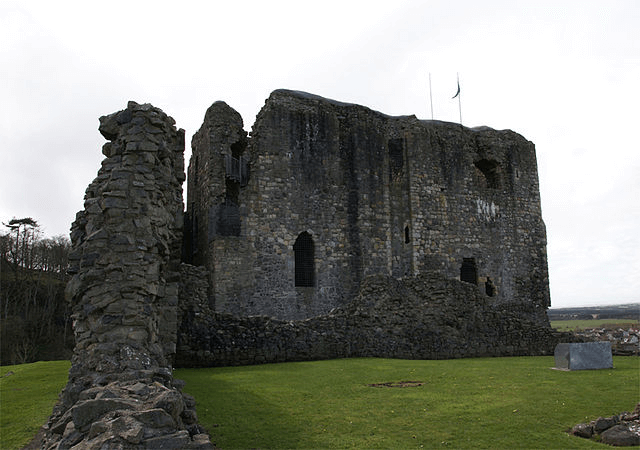







Brief History: Dundonald Castle stands as a testament to Scotland’s medieval past, with origins dating back to the 14th century. It was built as a royal fortress by Robert II, the first Stewart king of Scotland, and served as a symbol of the Stewart dynasty’s power and influence. Over the centuries, Dundonald Castle has witnessed significant historical events, including royal visits and military actions.
Architectural Highlights: The castle’s most prominent feature is its massive tower house, which dominates the landscape. This structure was designed for both defense and residential use, with thick walls, narrow slit windows, and a layout that includes a great hall, private chambers, and storage areas. The ruins also reveal the castle’s sophisticated construction techniques and the strategic importance of its location.
Visitor Information: Dundonald Castle is now managed by Historic Scotland and is open to the public. Visitors can explore the ruins, enjoy breathtaking views from the tower, and learn about the castle’s history at the visitor center. The center offers exhibitions, educational programs, and events throughout the year, making Dundonald Castle a vibrant cultural site as well as a historic landmark.
Photo Author Otter
Sorn Castle
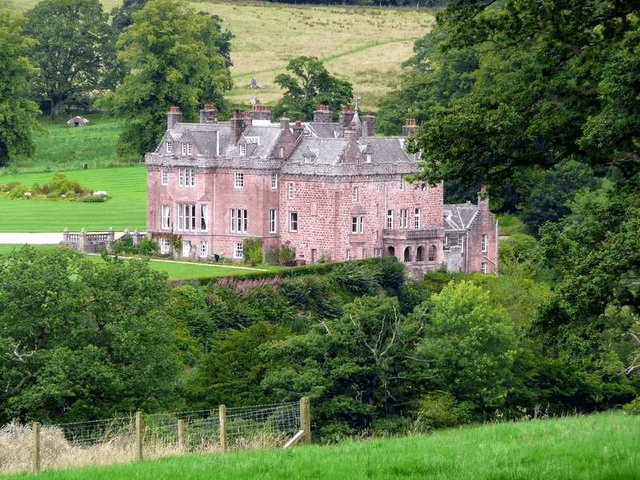







Brief History: Sorn Castle, a hidden gem nestled on the banks of the River Ayr, has a rich history that dates back to the 14th century. This privately owned castle has been the seat of the Hamilton family since the 15th century and has undergone numerous modifications and expansions over the centuries, reflecting the evolving tastes and architectural styles of its inhabitants.
Architectural Highlights: The castle features a blend of architectural styles, from its medieval tower house core to later additions that incorporated more modern, comfortable living spaces. Its strategic position overlooking the river and the surrounding landscape underscores its original defensive purpose, while the interior boasts period furnishings and detailed craftsmanship, offering a glimpse into the lives of its noble residents.
Visitor Information: Sorn Castle is primarily a private residence but opens its doors to the public for special events and by prior arrangement for weddings and private tours. The estate’s picturesque setting, with its well-maintained gardens and grounds, makes it an attractive venue for celebrations and gatherings. Visitors interested in experiencing the beauty and history of Sorn Castle should check the castle’s website or contact the estate directly for information on upcoming events and visiting opportunities.
Photo Attribution Gordon Brown / Sorn Castle from the River Ayr Way / CC BY-SA 2.0
Blairquhan Castle
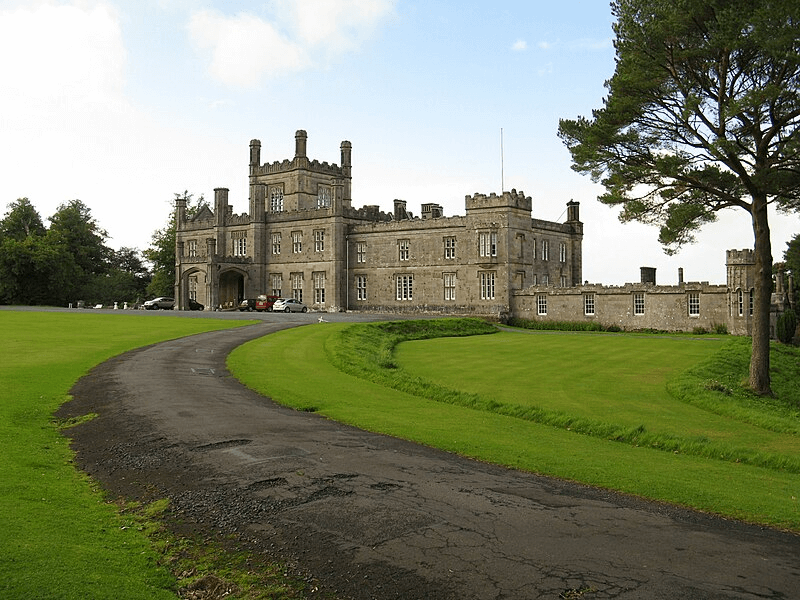







Brief History: Blairquhan Castle, set amidst the rolling hills of South Ayrshire, represents one of Scotland’s finest Regency castles. The current castle, built in the 1820s, replaced an earlier 15th-century tower house and was designed by the renowned architect William Burn. Over the years, Blairquhan has welcomed numerous distinguished guests, including Queen Victoria, and has been celebrated for its elegance, beauty, and the warmth of its hospitality.
Architectural Highlights: Blairquhan Castle’s architecture exemplifies the Regency era’s emphasis on harmony, proportion, and restrained ornamentation. The castle’s interiors are equally impressive, featuring exquisite plasterwork, fine furnishings, and a collection of artworks. The surrounding estate, with its landscaped gardens, woodlands, and river, complements the architectural splendor of the castle, creating a serene and picturesque setting.
Visitor Information: Today, Blairquhan Castle operates as a luxury hotel and venue for weddings, corporate retreats, and private events. The castle offers guided tours of its grounds and select interior spaces, allowing visitors to appreciate its historical and architectural significance. The estate also provides accommodation in beautifully appointed rooms and cottages, offering guests a taste of life in a Scottish castle.
Photo Author Jonathan Oldenbuck
Architectural Features of Ayrshire Castles
The castles of Ayrshire, like many across Scotland, exhibit a variety of architectural styles that evolved over centuries, reflecting changes in military technology, living standards, and aesthetic preferences. Initially, the region’s castles were simple motte-and-bailey structures, characterized by wooden defenses on raised earth mounds. However, as the need for more durable and imposing fortifications became apparent, stone castles began to emerge.
Stone Strongholds and Tower Houses
By the 12th century, stone began to replace wood as the primary material for castle construction in Ayrshire. This transition marked the appearance of formidable stone strongholds designed to withstand sieges and offer better protection for their inhabitants. These castles often featured thick walls, narrow slit windows for archers, and a central keep or tower that served as the last line of defense and residential quarters.
Tower houses became prevalent in the later medieval period, embodying a more compact and residential-focused design. These structures were typically three or four stories high, with the ground floor serving as storage and utility space, while the upper floors housed living quarters. Battlements and turrets not only provided defensive capabilities but also signaled the owner’s status and wealth.
Defensive Innovations
As warfare evolved, so did castle architecture. Curtain walls, encircling the entire castle, became thicker and were often complemented by a series of towers and battlements, enhancing the castle’s defensive perimeter. Moats, both dry and water-filled, added another layer of defense, deterring attackers and making direct assaults more difficult.
Murder holes, positioned above gateways or in ceilings, allowed defenders to attack assailants with arrows, hot oil, or rocks. Similarly, machicolations—stone projections with openings—were introduced to castles in Ayrshire, providing defenders the ability to target attackers directly at the base of the walls.
Preservation and Tourism
The preservation of Ayrshire’s castles is an ongoing challenge that involves various stakeholders, including local authorities, national heritage organizations, and private owners. These efforts are crucial not only for maintaining the structural integrity of the castles but also for safeguarding their historical significance for future generations.
Conservation Efforts
Conservation work on castles in Ayrshire encompasses a range of activities, from structural reinforcements and restoration of architectural details to the management of surrounding landscapes. Organizations such as Historic Environment Scotland play a pivotal role in these efforts, providing both funding and expertise. For castles like Culzean, which are under the care of the National Trust for Scotland, preservation also involves enhancing visitor experiences through educational programs and events.
Private ownership presents unique challenges and opportunities for preservation. Some castle owners undertake restoration projects to convert their properties into homes or hotels, thereby ensuring their upkeep through commercial ventures. These projects often require balancing historical authenticity with modern comforts, a task that demands careful planning and sensitivity to the castle’s original features.
Tourism and Access
Tourism is a vital aspect of Ayrshire’s castles, contributing to the local economy and providing the financial support necessary for their maintenance. Castles such as Culzean and Dundonald are major attractions, offering guided tours, historical reenactments, and other events that bring their rich histories to life. These activities not only educate visitors about Scotland’s past but also create a connection to the heritage that shapes the country’s identity.
Accessibility varies among the region’s castles, with some like Culzean Castle featuring extensive visitor facilities, including restaurants, shops, and interactive exhibits. Others, particularly those in ruinous states or private ownership, may have limited access but can often be admired from public viewpoints, offering a glimpse into Scotland’s feudal past.
Conclusion
The castles of Ayrshire are more than just stone and mortar; they are a testament to Scotland’s tumultuous history, architectural ingenuity, and cultural resilience. From the early wooden fortifications to the grand country houses of the Enlightenment, these castles have evolved, reflecting the changing needs, ambitions, and aesthetic sensibilities of their inhabitants.
Today, the preservation of these historical edifices and their integration into Scotland’s tourism industry underscore their continued relevance. They not only serve as a reminder of the past but also as a beacon for future generations, offering insights into the complexities of history, the nuances of architectural evolution, and the enduring allure of Scotland’s heritage.
As we conclude our exploration of Ayrshire’s castles, it’s clear that these structures hold a special place in the heart of Scotland. They remind us of the battles fought, the lives lived, and the histories woven into the fabric of the Scottish landscape. Whether you’re a history enthusiast, an architecture aficionado, or simply in search of beauty, Ayrshire’s castles offer a journey through time, inviting you to discover the stories etched into their ancient stones.
